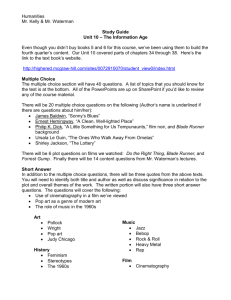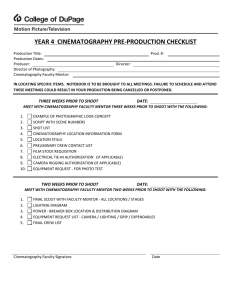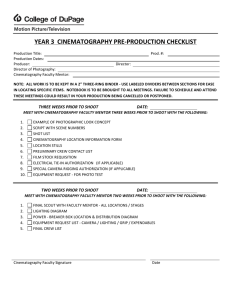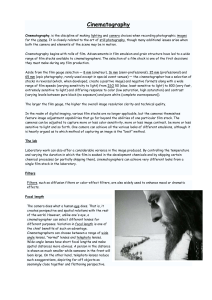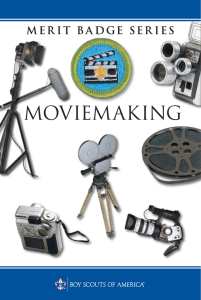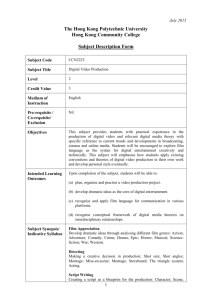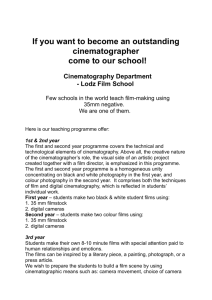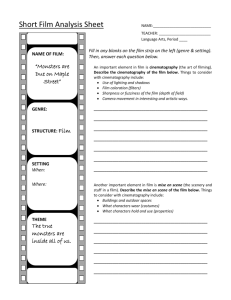Cinematography includes the fundamentals of producing motion
advertisement
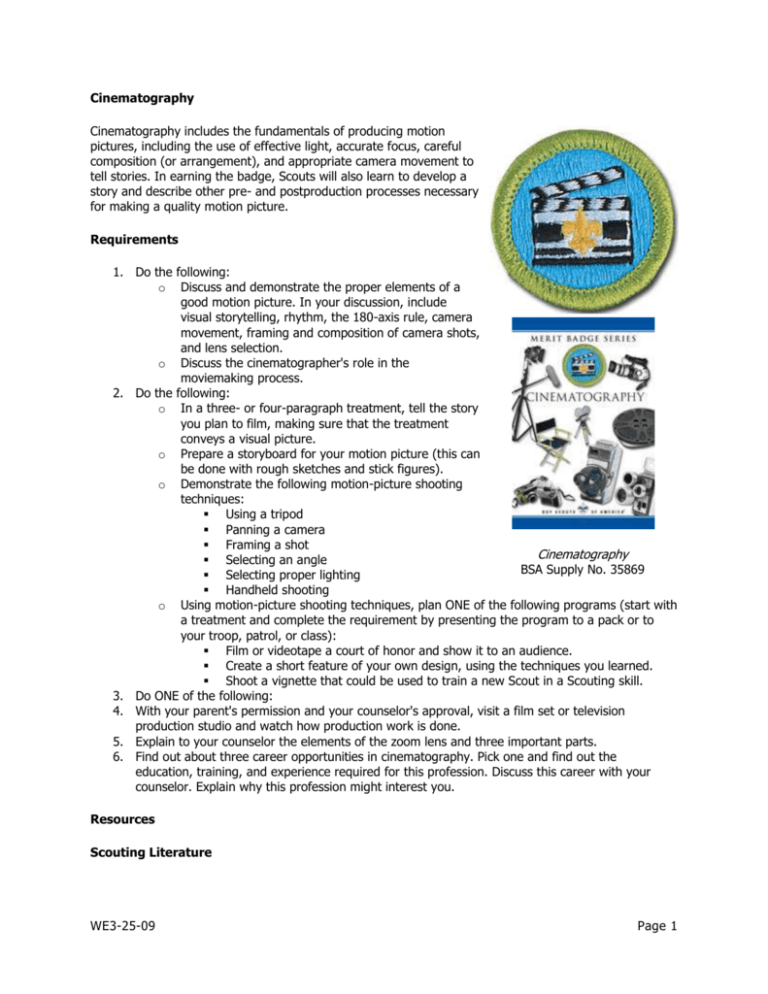
Cinematography Cinematography includes the fundamentals of producing motion pictures, including the use of effective light, accurate focus, careful composition (or arrangement), and appropriate camera movement to tell stories. In earning the badge, Scouts will also learn to develop a story and describe other pre- and postproduction processes necessary for making a quality motion picture. Requirements 1. Do the following: o Discuss and demonstrate the proper elements of a good motion picture. In your discussion, include visual storytelling, rhythm, the 180-axis rule, camera movement, framing and composition of camera shots, and lens selection. o Discuss the cinematographer's role in the moviemaking process. 2. Do the following: o In a three- or four-paragraph treatment, tell the story you plan to film, making sure that the treatment conveys a visual picture. o Prepare a storyboard for your motion picture (this can be done with rough sketches and stick figures). o Demonstrate the following motion-picture shooting techniques: Using a tripod Panning a camera Framing a shot Cinematography Selecting an angle BSA Supply No. 35869 Selecting proper lighting Handheld shooting o Using motion-picture shooting techniques, plan ONE of the following programs (start with a treatment and complete the requirement by presenting the program to a pack or to your troop, patrol, or class): Film or videotape a court of honor and show it to an audience. Create a short feature of your own design, using the techniques you learned. Shoot a vignette that could be used to train a new Scout in a Scouting skill. 3. Do ONE of the following: 4. With your parent's permission and your counselor's approval, visit a film set or television production studio and watch how production work is done. 5. Explain to your counselor the elements of the zoom lens and three important parts. 6. Find out about three career opportunities in cinematography. Pick one and find out the education, training, and experience required for this profession. Discuss this career with your counselor. Explain why this profession might interest you. Resources Scouting Literature WE3-25-09 Page 1 Architecture, Art, Communications, Model Design and Building, Photography, Public Speaking, and Theater merit badge pamphlets Books Andersen, Yvonne. Make Your Own Animated Movies and Videotapes: Film and Video Techniques From the Yellow Ball Workshop. Little Brown and Company, 1991. Andrew, James Dudley, ed. The Image in Dispute: Art and Cinema in the Age of Photography. University of Texas Press, 1997. Box, Harry. Set Lighting Technician's Handbook: Film Lighting Equipment, Practice, and Electrical Distribution. Focal Press, 2003. Brown, Blain. Cinematography: Image Making for Cinematographers, Directors, and Videographers. Focal Press, 2002. Ettedgui, Peter. Cinematography: Screencraft. Focal Press, 1999. Griffith, Richard, Arthur Mayer, and Eileen Bowser. The Movies: Revised and Updated Edition of the Classic History of American Motion Pictures. Random House Value Publishing, 1992. Katz, Steven D. Film Directing, Cinematic Motion, second ed. Michael Wiese Productions, 2004. ------. Film Directing Shot by Shot: Visualizing from Concept to Screen. Michael Wiese Productions, 1991. Laybourne, Kit. The Animation Book: A Complete Guide to Animated Filmmaking , revised ed. Three Rivers Press, 1998. Lowell, Ross. Matters of Light and Depth. Lower Light Management, 1999. Malkiewicz, Kris. Cinematography: The Classic Guide to Filmmaking , third ed. Fireside Press, 2005. Maltin, Leonard. The Art of the Cinematographer: A Survey and Interviews With Five Masters . Dover Publications, 1978. Mascelli, Joseph V. The Five C's of Cinematography: Motion Picture Filming Techniques . SilmanJames Press, 1998. Oxlade, Chris. Movies. Heinemann, 1997. Rickitt, Richard. Special Effects: The History and Technique. Watson-Guptill Publications, 2000. Samuelson, David W. David Samuelson's "Hands-On" Manual for Cinematographers. Focal Press, 1994. Scott, Elaine. Movie Magic: Behind the Scenes With Special Effects . HarperCollins Publishers, 1995. Zettl, Herbert. Sight, Sound, Motion: Applied Media Aesthetics, third ed. Wadsworth Publishing Company, 1998. WE3-25-09 Page 2
